Raan's Roost
The tavern has such a unique position because the whole city of Port Ountzos was built around Raan's lair, covering the surrounding islands and river delta. Serving and protecting the sailors at the nearby docks along with the warriors of the Followers of Raan, Raan's Roost is a renowned pub with legendary ale and great rooms.
Purpose / Function
Services avaliable include:
Design
From the storage room on the first floor, the bridge can be accessed. There is also a staircase to a basement level, which contains a wine cellar and more storage room.
A help wanted board can be found in the dining room near the eastern entrance, where odd jobs, crew postings, and occassionaly quests and bounties are posted for a small fee.
Crossing the bridge to the seastack takes you to the multi-story lighthouse. The first story is a living space for the proprietor, with a private living room, bathroom, and kitchenette present. Up a staircase lies the bedroom on the second floor and a maintence room on the third floor, with the sacred flame on the open level above the third floor. A trapdoor covers the staircase to protect the lower levels from wind and rain.
Entries
Sensory & Appearance
Entering the inn, the crash of the sea is supplanted by the talk of drunken patrons and hired music, while the sea's salt mixes with the strong scents of fish and alcohol. The wooden furniture is worn and well-used under the hands of customers, while the shell-pottery cups and plates are cold to the touch. When storms brew, the worst of the winds are kept at bay by the lighthouse - but the rains are not, and their incessant pitter-pattering provides white noise for the mess hall and an end to any silence those staying in the upstairs rooms may otherwise experience in the early hours of the morning when all the patrons have gone to bed.
If one is to venture into the kitchens the scent of food being prepared is overpowering, and the sounds of slicing, stirring, and the cooking-fire's crackle mix with those at the bar in the adjacent room. The kitchen is hot with the fires of the oven, while the storage area is somewhat cooler. Beneath the inn lies the cellar, a cold and somewhat damp stone expanse, packed wall to wall with casks and bottles of ale and wine. If the storage room door is open, the sounds of the upper floors carry to the cellar below - but if closed, then the cellars are eerily silent save for the occasional skittering and stirring of some unseen vermin or insect; the stone walls prove as excellent sonic insulators.
Traversing the bridge connecting the inn and lighthouse can be delightful on calm days; the sea below you, the salty wind tousling one's hair, and the view of the arch and horizon present from two sides. But on rough days and wet nights, the bridge is hazardous. Puddles of water collect on it's walkway, and strong winds from the south can threaten to knock a person over the side into the violent ocean below. The lighthouse itself is colder than the inn, what with a lack of a fireplace, but it is comfortable. As a lived in space, chairs and couches are well-used and well-padded, the kitchenette smells of rare spices, and on higher floors, the sea's crash is slightly diminished with altitude. At the top of the tower lies the sacred flame. Originally a burning orange glow in honor of the sun, the Order of Raan turned it green to honor the oxidization of their draconic mentor. This eldritch light guides sailors to the nearby harbor and wards off storms with it's enchantments. The soft green glow bathes the lighthouse and inn's whitewashed walls at night, giving Raan's Roost a somewhat arcane appearance.
Denizens
Patrons consist of regulars & newcomers. Regulars are made up of dock workers, fishermen, local laborers, prominent local merchants, followers of Raan, and nobles looking to slum among the lower classes. Newcomers are largely those traveling on a ship that has docked in the harbor, occasional tourists, merchants from distant lands, and the rare monster or supernatural entity looking for a drink. Some of the more zealous followers of Raan come by now and again seeking to buy the tavern and lighthouse from Tsiyu Gansini and reclaim the eternal sacred flame.
A small stage to the southern side of the dining room often is host to bards, stage magicians, and other etertainers who may be hired by Tsiyu or have merely wandered in and offered their serivces. These patrons often recieve discounted food, drink, and lodging.
Contents & Furnishings
Furniture is mostly wooden with some hide patterning, and the beds in the upstairs rooms are made of wooden frames and straw mattresses.
Valuables
Perishables:
Nonperishables:
Basic Supplies:
Alterations
Over time, the peninsula became a sea arch and a few decades ago the arch collapsed - leaving the lighthouse on a seastack and the bar on a barrier island. Repairs included expanding the bar to include rooms on the second story and a bridge to connect the two buildings.
Architecture
While most lighthouses in the area are built atop earthen mounds, the position of Raan's Roost atop a slim barrier island made such a technique both unnecessary and difficult. As such, the buildings foundations are the rocks they stand upon themselves. Completing the melting pot of the empire, the bridge connecting them is a stone bridge of dwarven engineering, coated in white stucco to better match it's surroundings.
Both the lighthouse, inn, and bridge are adorned with carvings and reliefs of the great dragon Raan, waves, shells, and other aquatic and draconic imagery. The lighthouse's decorations, especially the seaward ones, are far more eroded and worn than those on the relatively newer bridge and inn.
Defenses
History
After Raan's disapperance, the structure was briefly taken over as a sort of holy site of defense by the Followers of Raan, and the braizer of fire elemental command used to light the way for incoming ships was replaced with a sacred eternal flame in honor of The Sun. After a prolonged legal battle, the former owner of the lighthouse was able to reclaim her establishment, keeping the eternal flame.
After centuries of being bought and sold by various businessmen, pirates, a few adventurers, and a family of dragonborn, the structure passed to a human man named Tsiyu Gansini, a prominent merchant in Port Ountzos named for a historic general of the Order of Raan. He oversaw the collapse of the sea arch, rebuilding of the inn, and construction of the bridge. Now an old man, Tsiyustill oversees the operation of the inn and lighthouse, and is looking for a protege to train so he can finally retire.
Menus
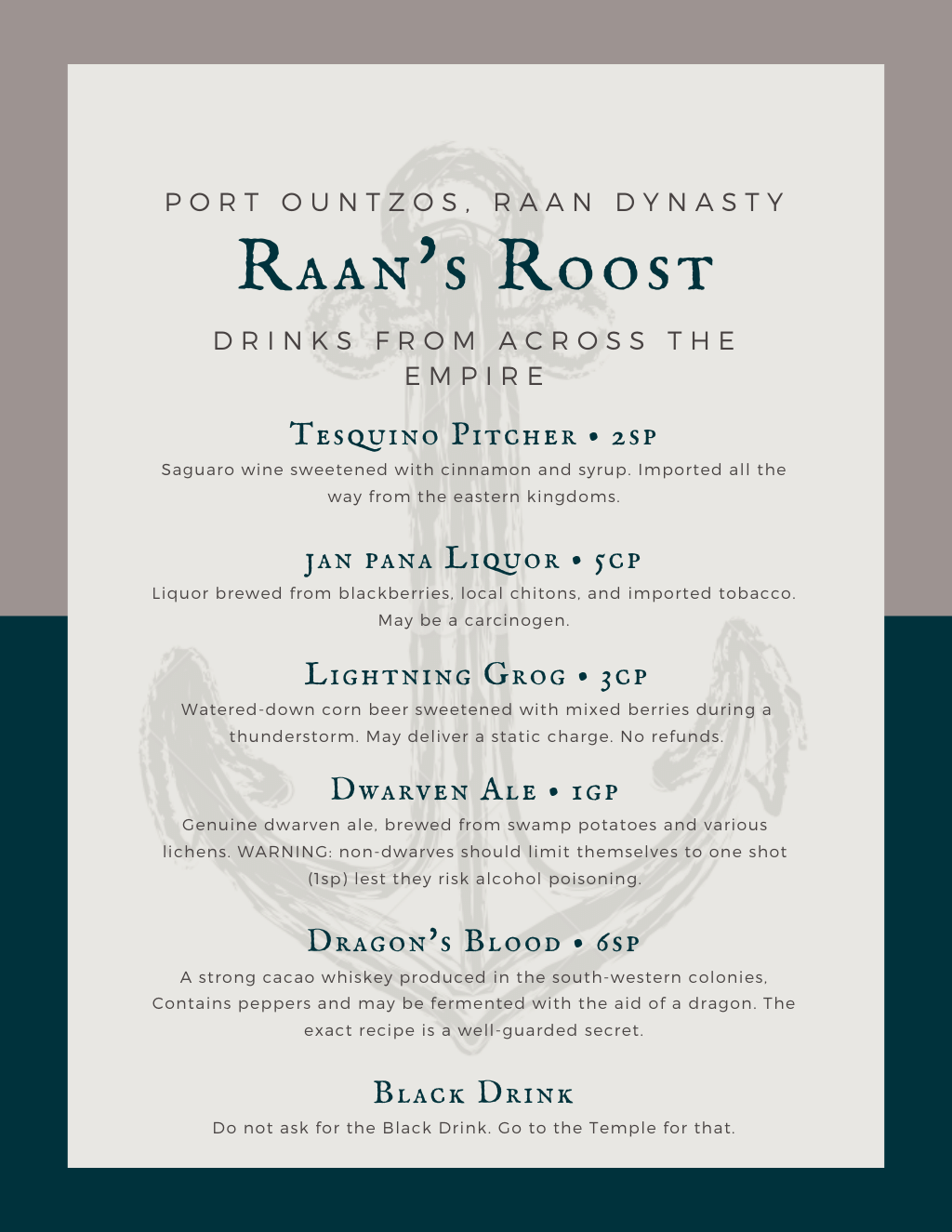
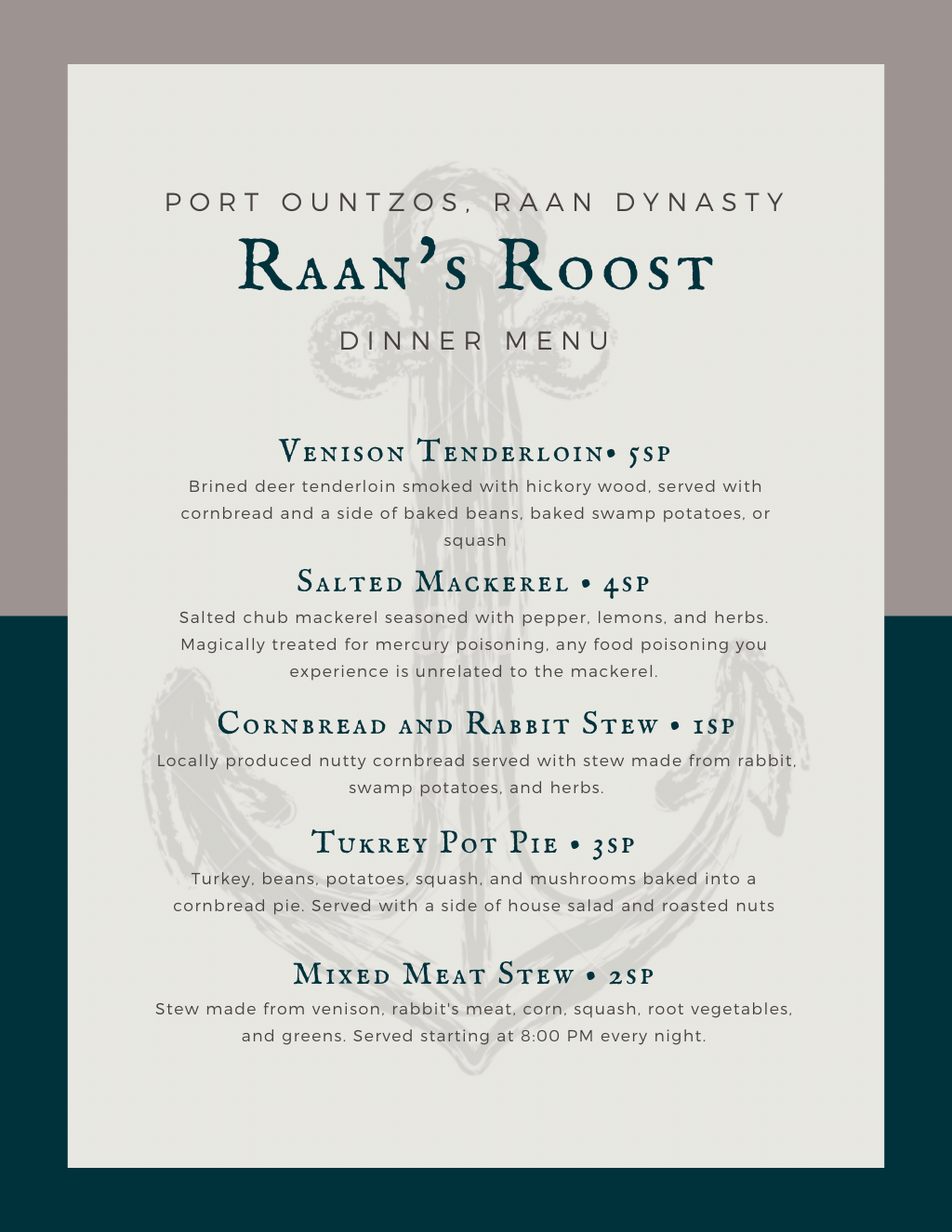
Maps

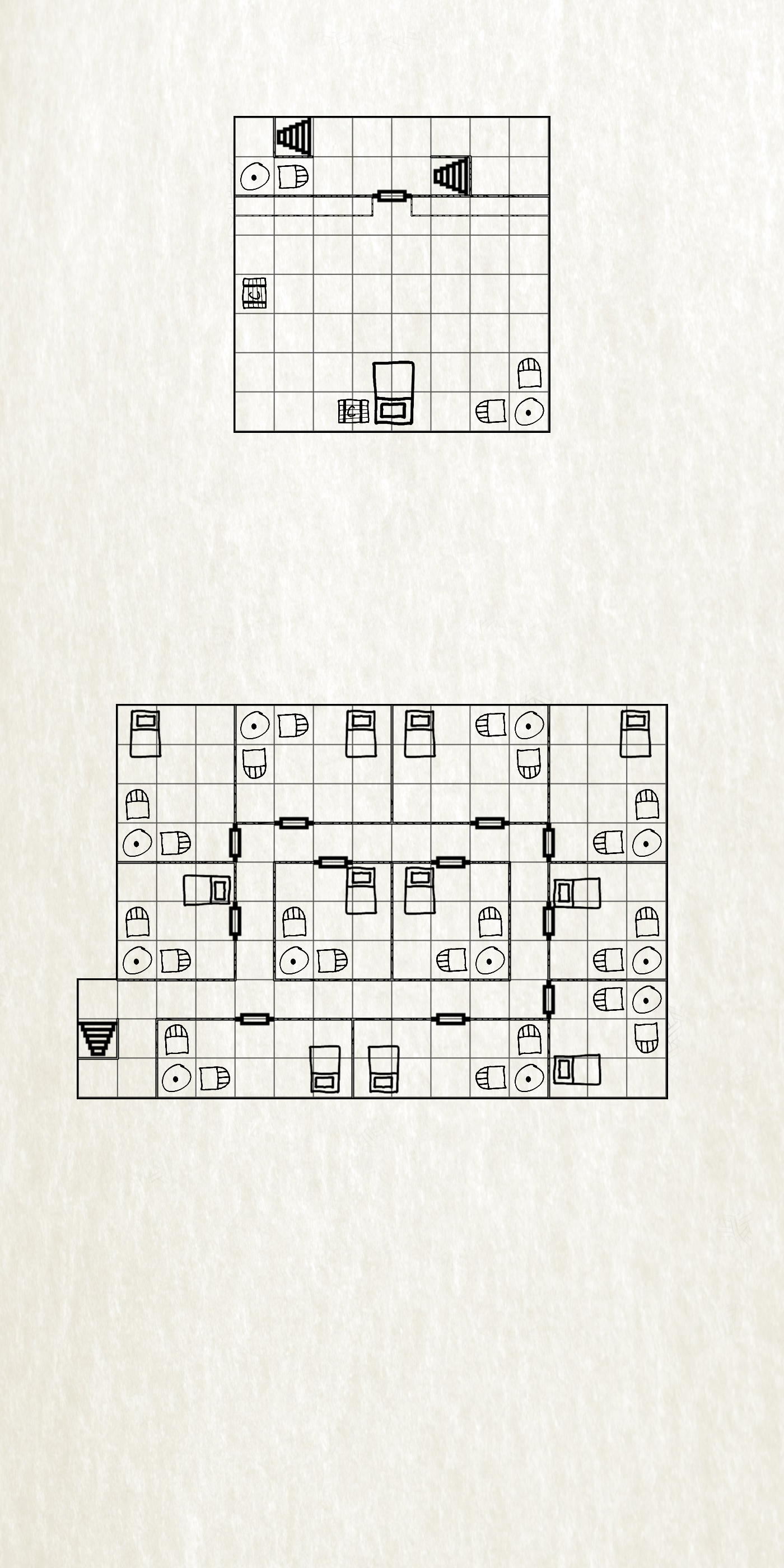


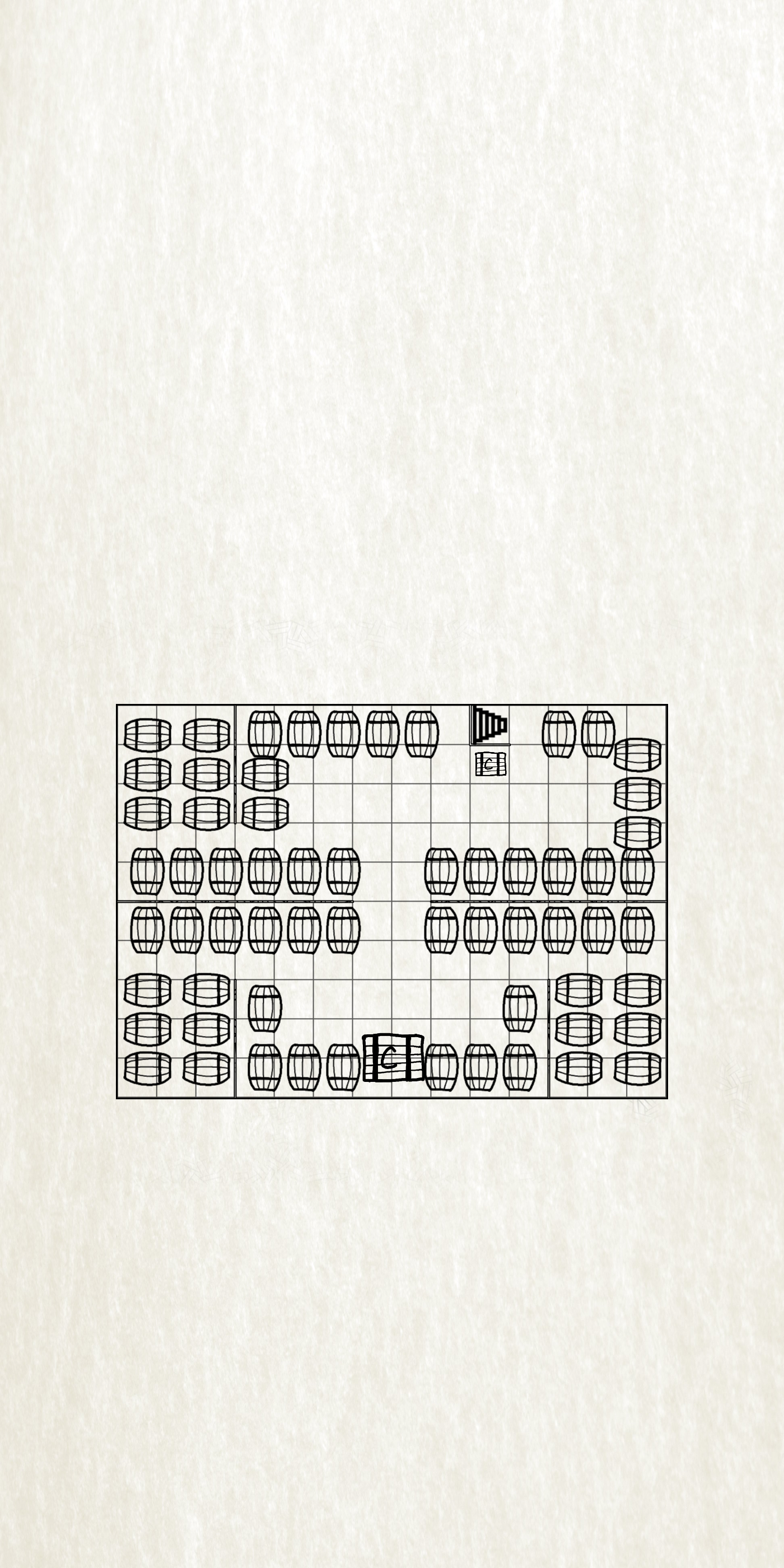

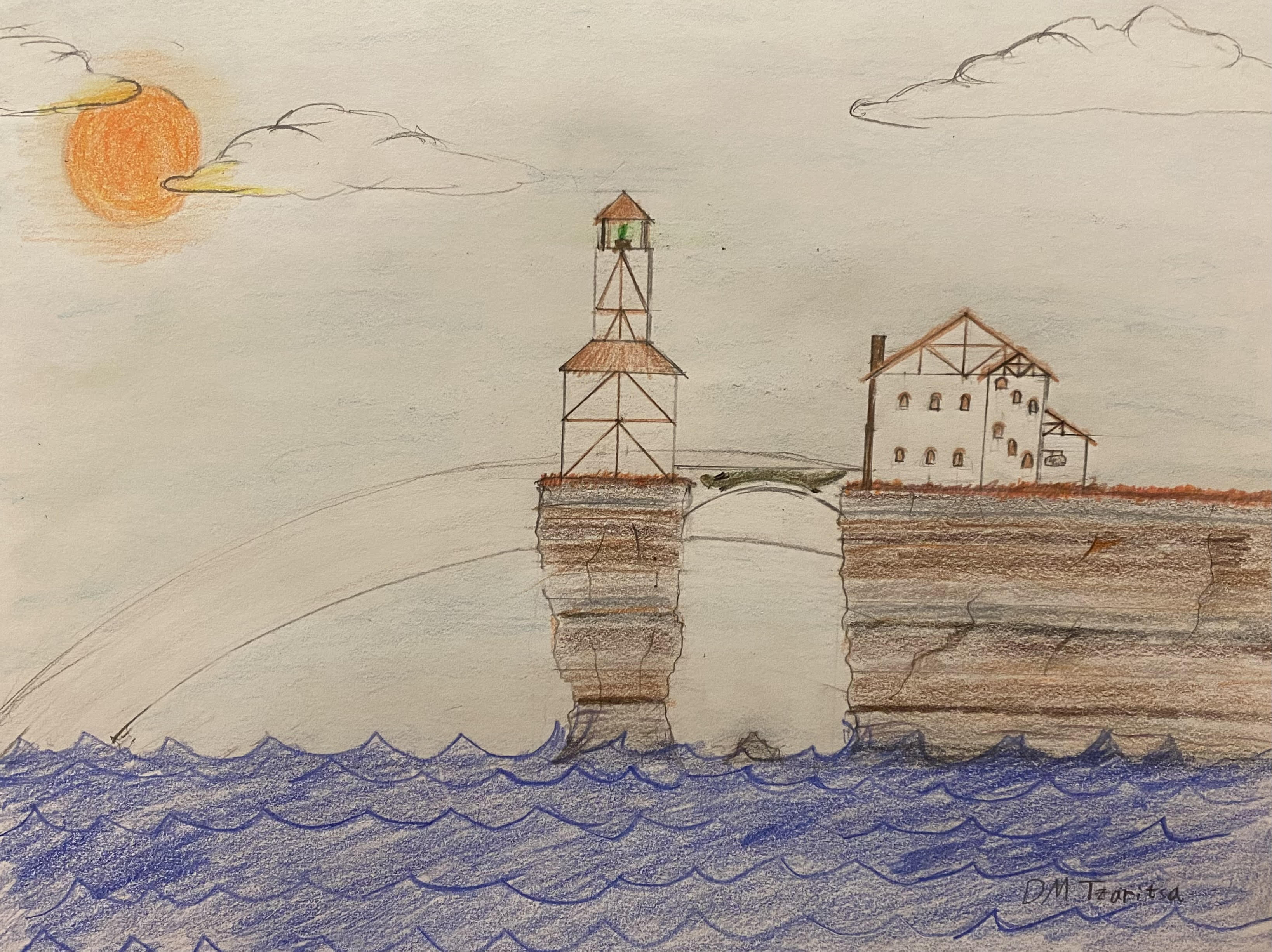

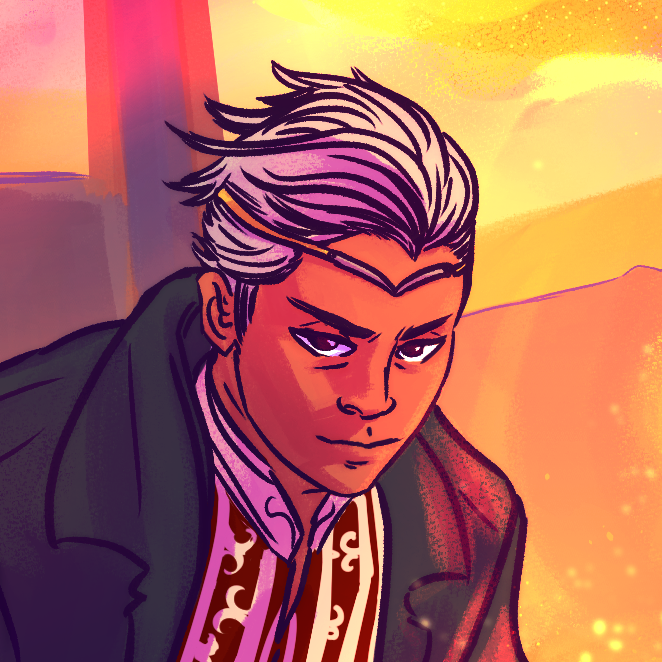

The banner, maps, and menu, are real nice and illustrative. I like the many roles this place plays, and it seems like a delightful place to stay with all the white noise to lull you to sleep. And while simple layoutwise, there's enough differences between sections to keep it easy to read.
Too low they build who build beneath the stars - Edward Young
Thank you! I wanted my tavern to be more than just a place to get drunk and sleep, and I needed an explanation for how Port Ountzos didn't get wiped off the map by monsoons - so, magical lighthouse it is!
When life gives you lemons, they're probably poisoned - The signature of some pessimisst on a defunct forum in 2014